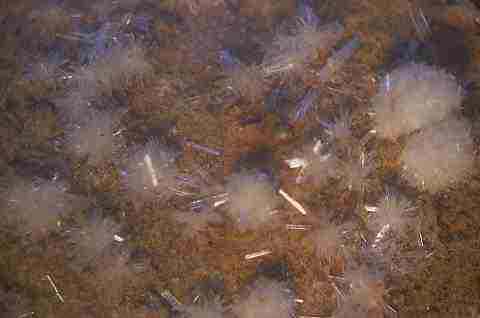Gypsum
Otaki, Chichibu city, Saitama pref., Japan

Field of view: 10 mm. Radial groups of gypsum. The radial groups of white prisms are gypsum. The light brown basement is limonite.
Recovered from a meteoric oxidation zone of a moderately low-temperature hydrothermal deposit combined with skarn formed by contact metamorphism of I-type (magnetite-series) quartz diorite. Formed in less than 50 years after the mine was closed.
Gypsum from this location was described in 1946.
The formation process of this specimen is considered by the dissolution reaction of pyrite by iron bacteria in oxygen-containing meteoric water and gypsum deposition from sulfate solution. For example, sulfate ion is formed by the following reaction:
[Inorganic reaction]
2FeS2 (Pyrite) + 7O2 + 2H2O = 2Fe2+ + 4SO42- + 4H+
[Iron bacteria]
4Fe2+ + O2 + 4H+ = 4Fe3+ + 2H2O
[Inorganic reaction]
FeS2 (Pyrite) + 14Fe3+ + 8H2O = 15Fe2+ + 2SO42- + 16H+
and Ca ion is formed by the following reaction:
CaCO3 (Calcite) + CO2 + H2O = Ca2+ + 2HCO3-
Reacting Ca iron with sulfate ion, gypsum deposits.
Ca2+ + SO42- = CaSO4 (Gypsum)
Other localities
- Chichibu Mine (Hydrothermal Skarn, Radial)
- Hitachi Mine (Besshi, Tabular)
- Okorogawa Mine (Hydrothermal, Prismatic)
- Su river (Smectitization, Prismatic)
- Uenohara (Mudstone, Radial)
- Kodo (Mudstone, Granular)
- Desert Cave Hotel (Shale, Hairy)